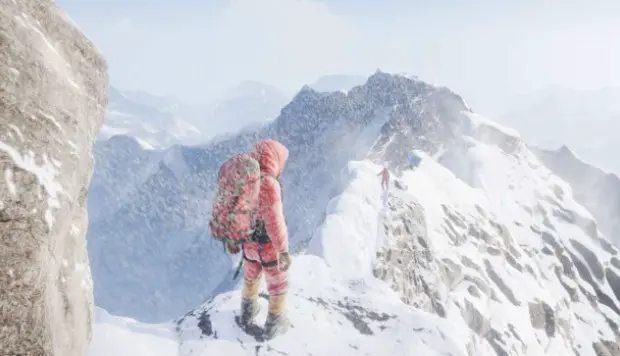The user looks down from the rope bridge, aware a wrong step will spell doom. An ill-advised pivot in one direction, or an awkward shuffle in another, and a plummet to the ice-coated rocks hundreds of feet below will result.
The consolation prize for this encounter with imminent mortality: the view. There are spectacular peaks, stark snowy backdrops and a sky as near as the attic ceiling.
Hardier souls might stand there a moment, taking in the sights, as the bridge’s temporary supports creak and ice underfoot breaks away and falls into the great beyond. This reporter, less aesthetically inclined when a possible death-hurtle is involved, hoofs it across the rungs with a few brisk and body-clenching strides.
Happy to have reached the other side, he feels a wave of relief. Then he spots a giant ladder on the side of the mountain face, stretching heavenward with Jacob-esque loftiness. Those familiar feelings of awe and doom come rushing back.
It is a weekday afternoon in Reykjavik, the world’s most northerly capital. Frozen peaks and other grand displays of nature sit just a short drive away. Yet I am standing in a sparsely decorated apartment not far from Reykjavik’s main square. These are the offices of Solfar Studios, an Iceland-based start-up of so-called pure VR.
Solfar, in conjunction with Icelandic visual effects company RVX, has createdEverest, a piece designed to evoke the soul-stirring beauty – and heart-stopping fear – of climbing the world’s tallest mountain.
The piece is nearly full-body – that is to say, leg or hand movements in real life are reflected in the experience. I’m wearing a headset and moving (“freely” would not be quite the word; perhaps “widely”?) around a large unfurnished living room, my senses convinced, in ways even VR can rarely persuade, that I am somewhere that is deeply somewhere else.
Everestis the latest experiment in the kind of bold visual content VR proponents have promised. When it debuts on the high-end HTC Vive headset this month,followed by PlayStation and Oculus platforms this year,Everestwill use VR to challenge our very conception of what we watch.
A series of five sequential chapters inEveresttakes the viewer, harrowingly, from just above base camp to the Hillary Step, the final climbing phase before the summit. And though the level of immersion and participation is on a par with some of the world’s strongest video games, creators have taken a different path: rather than build a typical game, in which the objective is to finish each level (and the game) as quickly as possible, the idea here is to soak in a real-life place most people will never see for themselves.
“We wanted it to feel like you’re the star of a first-person movie and not just someone playing a video game,” Solfar co-founder Thor Gunnarsson says as he leads me through the experience. “We wanted to slow it down so you’re actually living it.”
RVX is owned by Dadi Einarsson, a visual-effects veteran, and Baltasar Kormakur, the Iceland-based director of last year’s adventure-drama filmEverest. But though some of the piece’s moments will clearly evoke that movie – the rope bridge, for instance, contains similarities with Josh Brolin’s tentative walk as Beck Weathers, in a critical scene – the VREverestis not affiliated with the film.
In fact, RVX and Solfar didn’t use any film-style shoots in creating their piece. Instead, they relied on a process pioneered by Einarsson in which still photographic images are animated and brought to life with digital representations of people dropped in. The piece was created entirely in a studio yet feels as real as anything Hollywood produces.
In other words, how to classify something that feels as authentic as anything movies have yielded but was created through the most digital of processes?
If that wasn’t enough to blur the line between natural and artificial, creators aim to build a “VR selfie” component into the experience. Basically, you can take a 360-degree video that inserts you into the mountain backdrop so that it appears you climbed the mountain yourself.
Everestsuggests, perhaps more than any piece of content about a real-life place made to date, that VR can come tantalisingly close to replicating the real thing; this is as authentic as it gets without strapping on a backpack and hopping on a plane to Nepal.
It also comes close to VR nirvana, plunging one into an exotic world (if not, hopefully, a crevasse below).
(SOUTH CHINA MORNING POST)
 简体中文
简体中文



